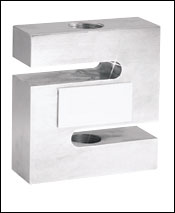New Sensor Developments
A few fiber optic load sensors are commercially available. One fiber optic strain gage can be installed by drilling a 0.5 mm diameter hole into a stud or bolt, and then inserting the strain gage into it. Such a sensor is completely insensitive to off-axis and torsion loads.
In the area of new sensor developments, fiber optic load cells are gaining attention because of their immunity to electromagnetic and radio frequency interference (EMI/RFI), suitability for use at elevated temperatures, and intrinsically safe nature. Work continues on the development of optical load sensors. Two techniques are showing promise: measuring the micro-bending loss effect of single-mode optical fiber and measuring forces using the Fiber Bragg Grating (FBG) effect. Optical sensors based on both technologies are undergoing field trials in Hokkaido, Japan, where they are being used to measure snow loads on electrical transmission lines.

"S" beam load cells for
compression or tension applications.
Micromachined silicon load cells have not yet arrived, but their development is underway. At the Universiteit Twente in the Netherlands, work is progressing on a packaged monolithic load cell using micromachining techniques, and it is possible that silicon load cells might dominate the industry in the future.